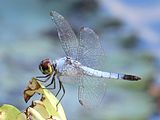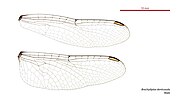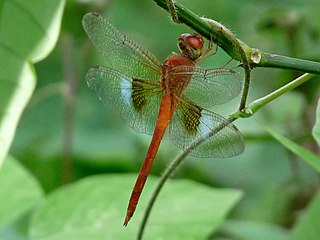
Tholymis tillarga, the coral-tailed cloudwing, is a species of dragonfly in the family Libellulidae. It is found from tropical West Africa to Asia, Australia and the Pacific Islands. Common names include old world twister, evening skimmer, crepuscular darter, foggy-winged twister and twister.

Orthetrum caledonicum, the blue skimmer, is a common Australian dragonfly in the family Libellulidae.

Orthetrum migratum is an Australian freshwater dragonfly species in the family Libellulidae. The common name for this species is rosy skimmer. It inhabits streams, boggy seepages, riverine pools and swamps across northern Australia.

Nannodiplax rubra, commonly called the pygmy percher, is a species of dragonfly in the monotypic genus Nannodiplax. Its distribution seems to be limited to Australia and New Guinea. They are tiny dragonflies with a bright red abdomen and clear wings. They are found near a wide variety of rivers and streams. The Australian distribution ranges from Broome, Western Australia via the north and east to around Coffs Harbour, New South Wales. The taxon has not yet been assessed for the IUCN Red List, but it is listed in the Catalogue of Life.

Brachydiplax duivenbodei is a species of dragonfly in the family Libellulidae. It is known by the common name darkmouth. It is native to Indonesia, the Solomon Islands, and Queensland in Australia.

Anax gibbosulus is a species of large dragonfly of the family Aeshnidae, commonly known as the green emperor. It inhabits swamps and brackish waters from India through northern Australia to the Pacific.

Hemigomphus gouldii is a species of dragonfly of the family Gomphidae, known as the southern vicetail. It is a small, black and yellow dragonfly, endemic to eastern Australia, where it inhabits permanent streams and rivers.

Neurothemis oligoneura is a species of dragonfly of the family Libellulidae, known as the spotted grasshawk. It is a medium-sized dragonfly with extensive darkening near the base of the wings found in northern Australia and New Guinea.
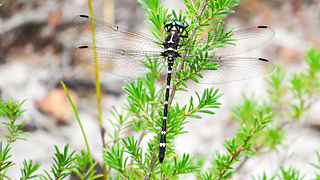
Eusynthemis tillyardi is a species of dragonfly of the family Synthemistidae, known as the mountain tigertail. It is a medium-sized dragonfly with black and yellow markings. It inhabits coastal and mountain streams in south-eastern Australia
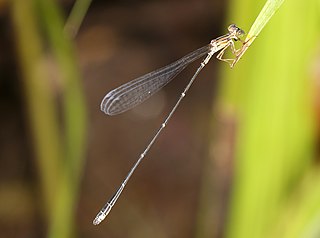
Oristicta filicicola is a species of damselfly belonging to the family Isostictidae. Until 2017 it was the only species of the genus Oristicta. Commonly known as a slender wiretail, it is a slender and dull-coloured damselfly of medium-size. It is endemic to north-eastern Australia, where it inhabits streams in rainforests.

Austrocnemis splendida is a species of damselfly in the family Coenagrionidae, commonly known as a splendid longlegs.

Austrolestes aridus is an Australian species of damselfly in the family Lestidae, commonly known as an inland ringtail. It is widespread across inland Australia, where it inhabits streams, pools, and ponds.

Diphlebia nymphoides is a species of Australian damselfly in the family Lestoideidae, commonly known as an arrowhead rockmaster. It is endemic to eastern Australia, where it inhabits streams and rivers.

Austroargiolestes alpinus is a species of Australian damselfly in the family Megapodagrionidae, commonly known as a New England flatwing. It is endemic to north-eastern New South Wales, where it inhabits streams and bogs.
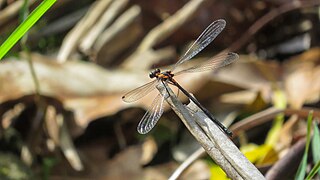
Austroargiolestes amabilis is a species of Australian damselfly in the family Megapodagrionidae, commonly known as a flame flatwing. It is endemic to eastern Australia, where it inhabits streams in rainforest.

Austroargiolestes calcaris is a species of Australian damselfly in the family Megapodagrionidae, commonly known as a powdered flatwing. It is endemic to south-eastern Australia, where it inhabits streams, deep pools and bogs, generally in mountainous areas.
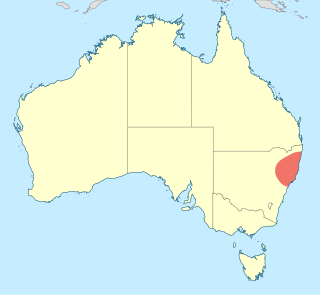
Austroargiolestes brookhousei is a species of Australian damselfly in the family Megapodagrionidae, commonly known as a Barrington flatwing. It is endemic to northern New South Wales, where it inhabits streams and bogs.

Austroargiolestes christine is a species of Australian damselfly in the family Megapodagrionidae, commonly known as a milky flatwing. It is endemic to mountain areas of northern New South Wales, where it inhabits streams and boggy areas.
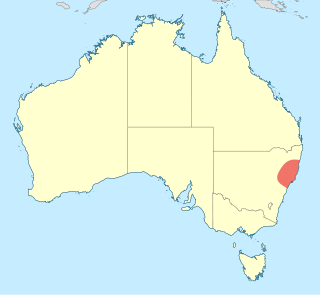
Griseargiolestes bucki is a species of Australian damselfly in the family Megapodagrionidae, commonly known as a turquoise flatwing. It is endemic to the Barrington Tops area of New South Wales, where it inhabits streams, bogs and seepages.

Griseargiolestes fontanus is a species of Australian damselfly in the family Megapodagrionidae, commonly known as a springs flatwing. It is endemic to south-eastern Queensland and north-eastern New South Wales, where it inhabits streams near their springs.





